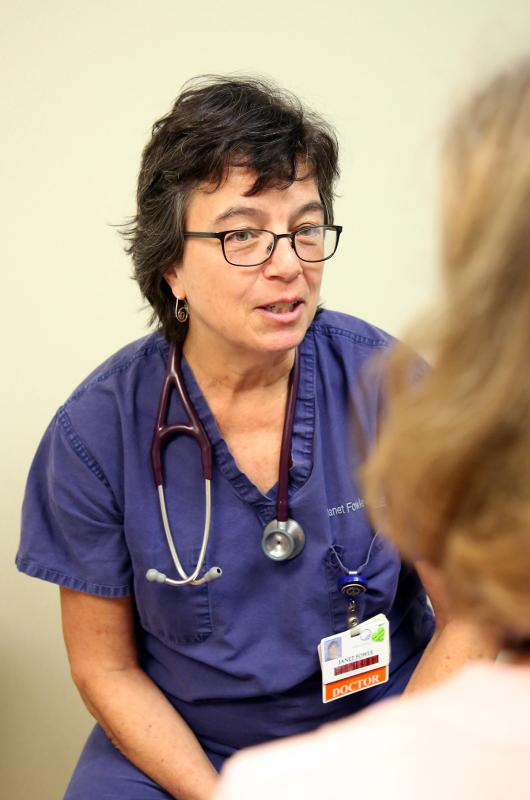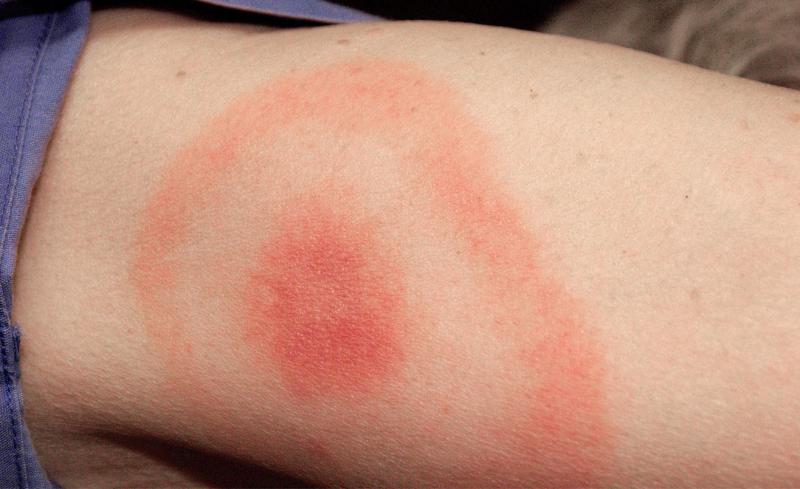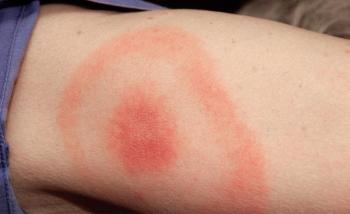New tick-borne diseases sending people to emergency department, hospital
 Janet Fowle, MD, is an emergency department physician at the Miles Campus of LincolnHealth and at the urgent care center on the St. Andrews Campus of LincolnHealth. Emergency physicians at LincolnHealth are seeing a relatively high incidence of tick-borne diseases this year. Courtesy photo
Janet Fowle, MD, is an emergency department physician at the Miles Campus of LincolnHealth and at the urgent care center on the St. Andrews Campus of LincolnHealth. Emergency physicians at LincolnHealth are seeing a relatively high incidence of tick-borne diseases this year. Courtesy photo
 Lyme disease is usually diagnosed through the presence of a target, or bulls-eye rash more than two inches in diameter. Other symptoms of Lyme disease include flu-like symptoms, a stiff neck, chills, fever, swollen lymph nodes, headaches and joint pain. Courtesy photo
Lyme disease is usually diagnosed through the presence of a target, or bulls-eye rash more than two inches in diameter. Other symptoms of Lyme disease include flu-like symptoms, a stiff neck, chills, fever, swollen lymph nodes, headaches and joint pain. Courtesy photo
 Janet Fowle, MD, is an emergency department physician at the Miles Campus of LincolnHealth and at the urgent care center on the St. Andrews Campus of LincolnHealth. Emergency physicians at LincolnHealth are seeing a relatively high incidence of tick-borne diseases this year. Courtesy photo
Janet Fowle, MD, is an emergency department physician at the Miles Campus of LincolnHealth and at the urgent care center on the St. Andrews Campus of LincolnHealth. Emergency physicians at LincolnHealth are seeing a relatively high incidence of tick-borne diseases this year. Courtesy photo
 Lyme disease is usually diagnosed through the presence of a target, or bulls-eye rash more than two inches in diameter. Other symptoms of Lyme disease include flu-like symptoms, a stiff neck, chills, fever, swollen lymph nodes, headaches and joint pain. Courtesy photo
Lyme disease is usually diagnosed through the presence of a target, or bulls-eye rash more than two inches in diameter. Other symptoms of Lyme disease include flu-like symptoms, a stiff neck, chills, fever, swollen lymph nodes, headaches and joint pain. Courtesy photo
Diseases with unfamiliar names like anaplasmosis and babesiosis are a growing health threat in Lincoln County, causing people to be hospitalized with severe flu-like symptoms as the Midcoast area sees the fastest growth in tick-borne diseases in the state.
Lyme disease, which reached record levels last year in both Maine and Lincoln County, continues to be the most common tick-borne disease, but anaplasmosis and babesiosis, which can be serious or even fatal to the elderly, very young or people with impaired immune systems, are growing more rapidly and are present in Lincoln County at a much higher level than most of the rest of the state.
Through June of this year, Lincoln County had nine out of 56 cases (16 percent) of anaplasmosis reported in Maine and two out of five cases of babesiosis, or 40 percent all cases reported in Maine up to that point, according to the Maine Centers for Disease Control and Prevention. Because of the nature of reporting, there is a significant lag between reported numbers and the actual numbers of cases in hospitals, so it is not clear if those trends continued later in the summer.
It is clear, however, that as new tick-borne diseases become more common, Lincoln County residents should take precautions when they head into the woods or brushy areas where ticks are most common.
Precautions against tick-borne diseases (Source U.S. Centers for Disease Control):
- Ticks live in moist or humid environments in woody or grassy areas. When hiking, walk in the center of trails and when possible and wear long pants and sleeves.
- Use permethrin on clothes, boots and any camping gear. Permethrin kills ticks and is usually effective after several washing cycles. Use a repellent with DEET on skin.
- After you come in from outdoors, check your skin and your clothing for signs of ticks. Remove ticks if you find them. Washing clothes may not kill ticks, but the high heat cycle in the dryer normally does.
- Shower soon after coming indoors and check skin everywhere (including under arms, in and around ears, belly button and scalp) for ticks.
- If you find a tick, remove it. Watch for signs of illness, such as a rash, fever, flu-like symptoms or aching joints in the days and weeks after the tick bite and see your health care provider if symptoms are present.
- For more information: http://www.cdc.gov/features/stopticks.
Ticks are generally found in brushy or woody areas. They wait on grass, leaves or branches for a host to approach and then climb on as the host brushes up against them.
All three diseases, Lyme disease, anaplasmosis and babesiosis, are spread primarily by the deer tick, which is the size of a poppy seed in the spring, when many people contract the diseases. Later in the year it grows to about the size of an apple seed.
Lyme disease in Maine has increased in nine out of the last ten years, reaching a record 1,400 cases in 2014 or 105.3 cases per 100,000 people, roughly 10 times the national average. In Lincoln County, the rate of Lyme was 240 cases per 100,000 more than twice Maine’s average and the second highest rate in the state, behind only Knox County.
While anaplasmosis and babesiosis are both much less common than Lyme, they are increasing at a faster rate, particularly in Lincoln County, which also had the second highest rate of both of these diseases in 2014, again behind Knox County.
Anaplasmosis has grown from 17 cases in 2010 to 191 in Maine last year, with the number of cases slightly more than doubling from 2013 to 2014. Babesiosis is growing at a slower rate but has increased from 5 cases in 2010 to 42 last year.
As Lyme and other tick-borne diseases become more common, Lincoln Health Emergency Physician Janet Fowle, MD, said it is very important that people understand how to protect themselves and when they need to seek treatment. She noted that officials from the U.S. Centers for Disease Control have said that Lyme disease is almost certainly much higher than reported.
Lyme disease is treatable with antibiotics if caught early — most patients (about 80 percent) are diagnosed with a target-shaped rash more than two inches wide. If it is not caught early, it can cause a wide range of debilitating symptoms, including swollen joints, shooting pain, partial paralysis of the face (Bell’s palsy) or heart problems.
Dr. Fowle said it is important that people check themselves and their family members for ticks and the tell-tale rash, which can be in hard-to-see areas like the scalp or back.
It is also important that people check themselves for ticks, because the longer a tick has been attached, the more likely it is to have transmitted a disease, said Fowle. She said it is also possible for someone to catch more than one disease from one tick. If a tick has been attached for longer than 24 hours, she said people should call their primary care provider or consider going to an urgent care center.
Anaplasmosis, which is also caused by bacteria, has an incubation period of about one to two weeks and includes symptoms like fever, shaking, chills, headaches, gastrointestinal problems and in rare cases a rash.
Babesiosis, also caused by bacteria, has an incubation period of between one to nine weeks and can be life-threatening, particularly for older people, the very young or people with impaired immune systems. Symptoms may include fever, chills, sweats, malaise, headaches and gastrointestinal problems.
Still very rare in Maine, but very dangerous is Powassan disease, which is caused by a virus. Powassan has an incubation period of from one to four weeks. Symptoms include fever, headaches, vomiting and general weakness, seizures and altered mental status.
Chuck Lubelczyk, a biologist with the Vector-borne Disease Laboratory at the Maine Medical Center Research Institute, doesn’t recommend that people stay out of the woods, but he said it is important for people to think about preventing tick bites.
Even the lightest fabric will prevent a tick bite, he said. When he and other researchers are working in the woods, they wear long pants and shirts and often use gaiters and coat their clothing with permethrin, an insecticide that still works after several wash cycles.
Lubelczyk said there are about 15 different species of ticks in Maine and the deer tick is a fairly new arrival, only showing up in southern Maine in the 1980s.
While Lyme disease spread relatively quickly and is now found in every county in Maine, anaplasmosis is following the same trend, although it is many years behind, said Lubelczyk.
Some of the reasons for the increased incidence of tick-borne diseases in the midcoast, including a higher deer population — deer are the deer tick’s primary host. Also, a lot of habitat that had once been used for farming in the past 100 years has gone back to forest land, providing excellent habitat for deer. Finally, more people are moving to the area and living in woody areas, where they are more likely to come in contact with ticks.
For more information about tick-borne diseases and how to prevent them, go to http://www.cdc.gov/lyme/index.html or http://www.cdc.gov/features/stopticks.
Event Date
Address
United States

























